70+ Unimaginable Human Trafficking Statistics in The US
Let’s take a deeper dive into the statistics behind human trafficking, the levels of human trafficking in the United States, the profit made due to the illegal activity, and the two main types of trafficking.
.avif)
Human trafficking is often defined as the practice of exploiting adults and children for use as commodities, or objects, in conditions of sexual and labor servitude.
It’s a horrible criminal industry where people profit over the imposed misery and forced servitude of other people.
There are two main types of human trafficking, although there are many different ways it can occur. The two main types are labor trafficking and sex trafficking.
To make matters worse, these criminals make a profit by trafficking other people AND their victims can be anyone. Men, women, and children of any race, any age, and in any condition can fall victim.
Although most victims are female, men aren’t immune to serving this criminal underbelly.
Unfortunately, though, most victims are children. They’re easier to capture, subdue, and obtain for human trafficking. Many industries need workers who are smaller in size, have smaller hands, and can’t escape the abuse endured.
Let’s take a deeper dive into the statistics behind human trafficking, the levels of human trafficking in the United States, the profit made due to the illegal activity, and the two main types of trafficking.
Overall Human Trafficking Statistics
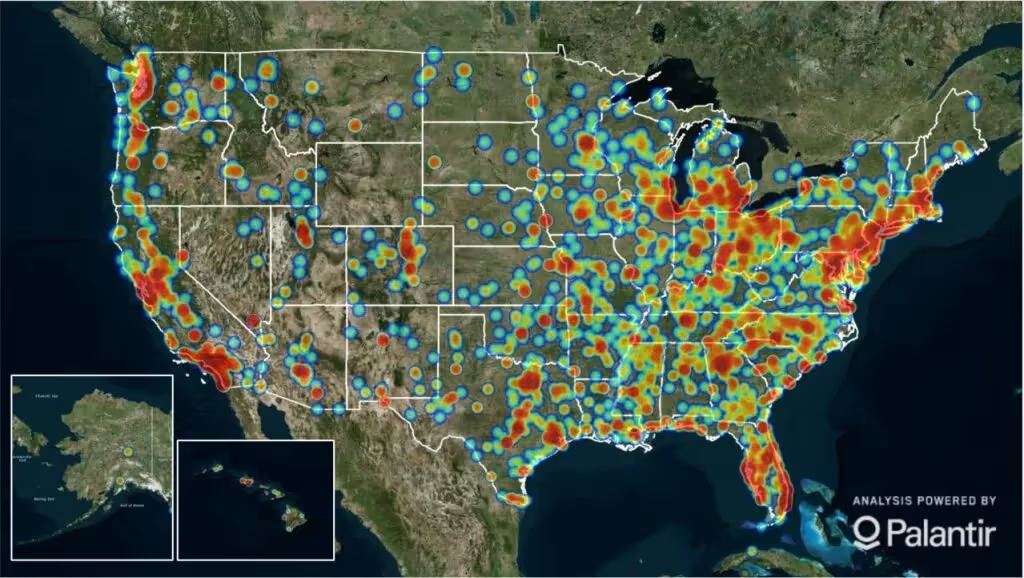
Above is a heatmap that showcases all of the locations in the United States where human trafficking occurred during 2019.
Scary right? The numbers aren’t much better.
For every 10,000 people living in the world, 54 people become enslaved in some form of human trafficking. Most people who are victims of human trafficking are female, but a good percent of victims are male.
To make it worse, 25% of victims are children who are in forced labor, sex trafficking, and even forced marriage.
Before getting into the details behind different aspects of human trafficking, we need to understand some facts that put human trafficking in perspective...
- 40.3 million people are victims of trafficking worldwide. (nealdavislaw.com)
- There are 5.4 victims of modern slavery for every 1,000 people in the world. (nealdavislaw.com)
- Women and girls account for 71% of all human trafficking victims. (nealdavislaw.com)
- 9% of human trafficking victims are men and boys. (humanrightsfirst.org)
- 1 in 4 victims of modern slavery are children. (cbp.gov)
- 30.2 million, or 75%, of human trafficking victims are 18 or older. (nealdavislaw.com)
- 25%, or 10.1 million people, of human trafficking victims are under the age of 18. (humanrightsfirst.org)
- 14% of victims of forced labor moved either internally or internationally. The rest do not relocate when trafficked. (humanrightsfirst.org)
- 15.4 million victims of human trafficking involve forced marriage. (nealdavislaw.com)
- There are 5.4 victims of modern slavery for every 1,000 people in the world. (nealdavislaw.com)
Human Trafficking Across The Country
Human trafficking in the U.S. is a terrifying thought.
Many people in the U.S. don’t want to admit that there is human exploitation going on. Many don’t want to admit that citizens and visitors go missing due to human trafficking. The sad truth is that it does happen, and at higher rates than you imagine.
Which states have the lowest rates of human trafficking? Vermont, Wyoming, Rhode Island, New Hampshire, and Alaska are the five states with the lowest rates of enslaved people according to World Population Review.
So which states have the highest rate of human trafficking? World Population Review compiled a list of human trafficking occurrences on the state-level, per 100k people...
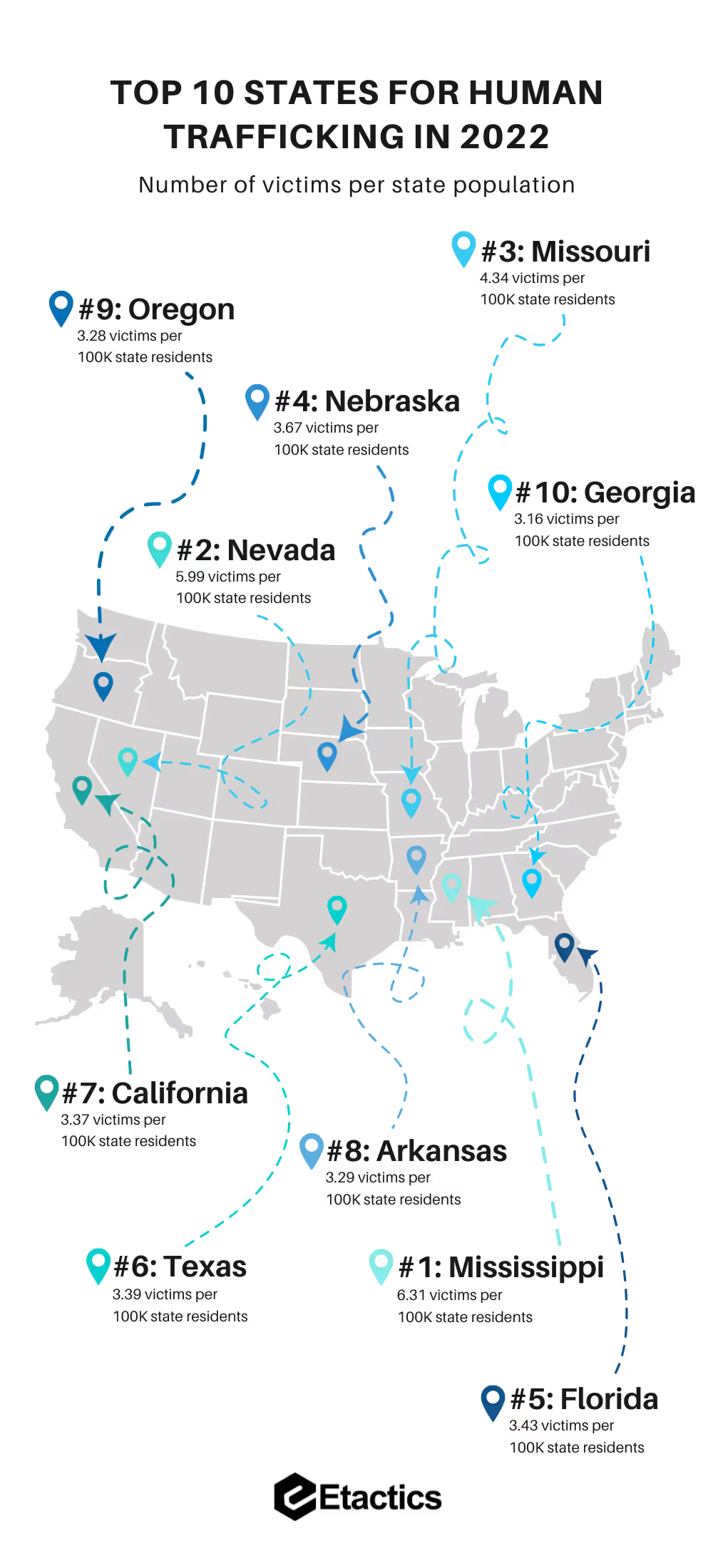
- Nevada has 7.50 trafficked people
- Mississippi has 4.99 trafficked people
- Florida has 4.08 trafficked people
- Georgia has 3.85 trafficked people
- Ohio has 3.84 trafficked people
- Delaware has 3.84 trafficked people
- California has 3.80 trafficked people
- Missouri has 3.78 trafficked people
- Michigan has 3.64 trafficked people
- Texas has 3.63 trafficked people
Below, you can see an image of the arrests the FBI conducted related to human trafficking. Texas, Minnesota, Nevada, Florida, and Wisconsin were the top 5 states for FBI arrests in 2019 related to human trafficking.
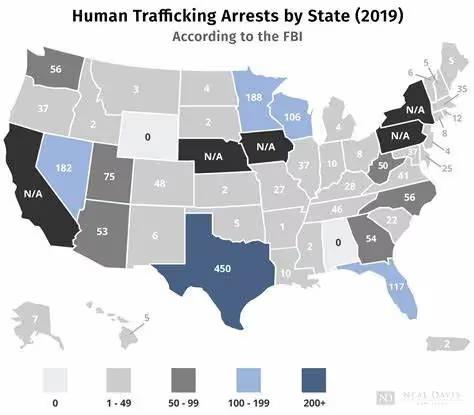
However, in more recent months, some of the statistics are different. Just because some states have high arrest rates doesn’t mean that the rate of trafficked individuals is proportionate. For example, Nevada has the highest rate of trafficked people but has a relatively low population.
Human Trafficking Statistics by State
Since human trafficking happens on such a large scale across the US, the federal government relies heavily upon states to protect their citizens.
This leads to variations in definitions and organizational requirements based on location.
For example, the Texas Attorney General defines human trafficking as “modern-day slavery.” More specifically, Section 20A.01(4) of the Texas Penal Code defines human trafficking as “… means to transport, entice, recruit, harbor, provide, or otherwise obtain another person by any means.”
Even though Texas ranked lower on the list provided in the previous section, it’s one of the largest states in the US. Making it a central hub for this type of crime.
Texas Human Trafficking Statistics
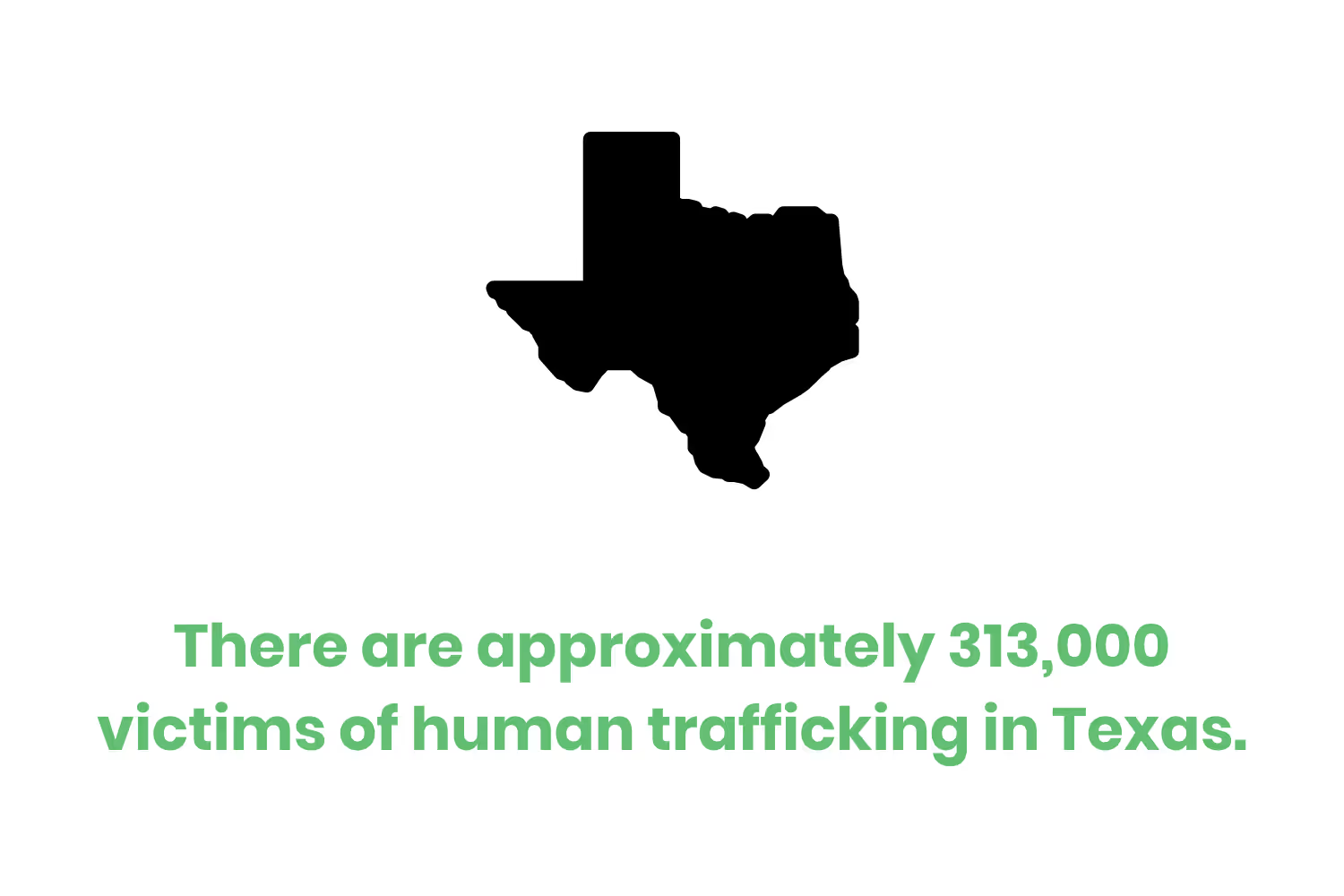
- Texas houses approximately 313,000 human trafficking. (The IC² Institute)
- Minor and youth sex trafficking costs the state of Texas approximately $6.6 billion. (The University of Texas at Austin)
- Nearly 234,000 adults are victims of labor trafficking in Texas. (The Refuge)
- In 2019, Texas experienced 1,080 reported cases of human trafficking (National Human Trafficking Hotline)
- Almost 20% of all trafficking victims in the U.S. travel through Texas, usually on the Interstate 10 corridor. (Center for Public Policy Studies)
- El Paso and Houston are identified as Texas cities with a particularly high level of human trafficking. (Texas Advisory Committee to the United States Commission on Civil Rights)
- Texas law enforcement rescued 91 people from a home in Houston in April 2021. (KXAN)
- In May 2021, signed legislation (HB 390) mandating that hotel, motel, inn, or similar business operators with more than 10 rooms offering fee-based temporary lodging require each of their employees to complete an annual human trafficking awareness and prevention training program. (HRWorks)
California Human Trafficking Statistics
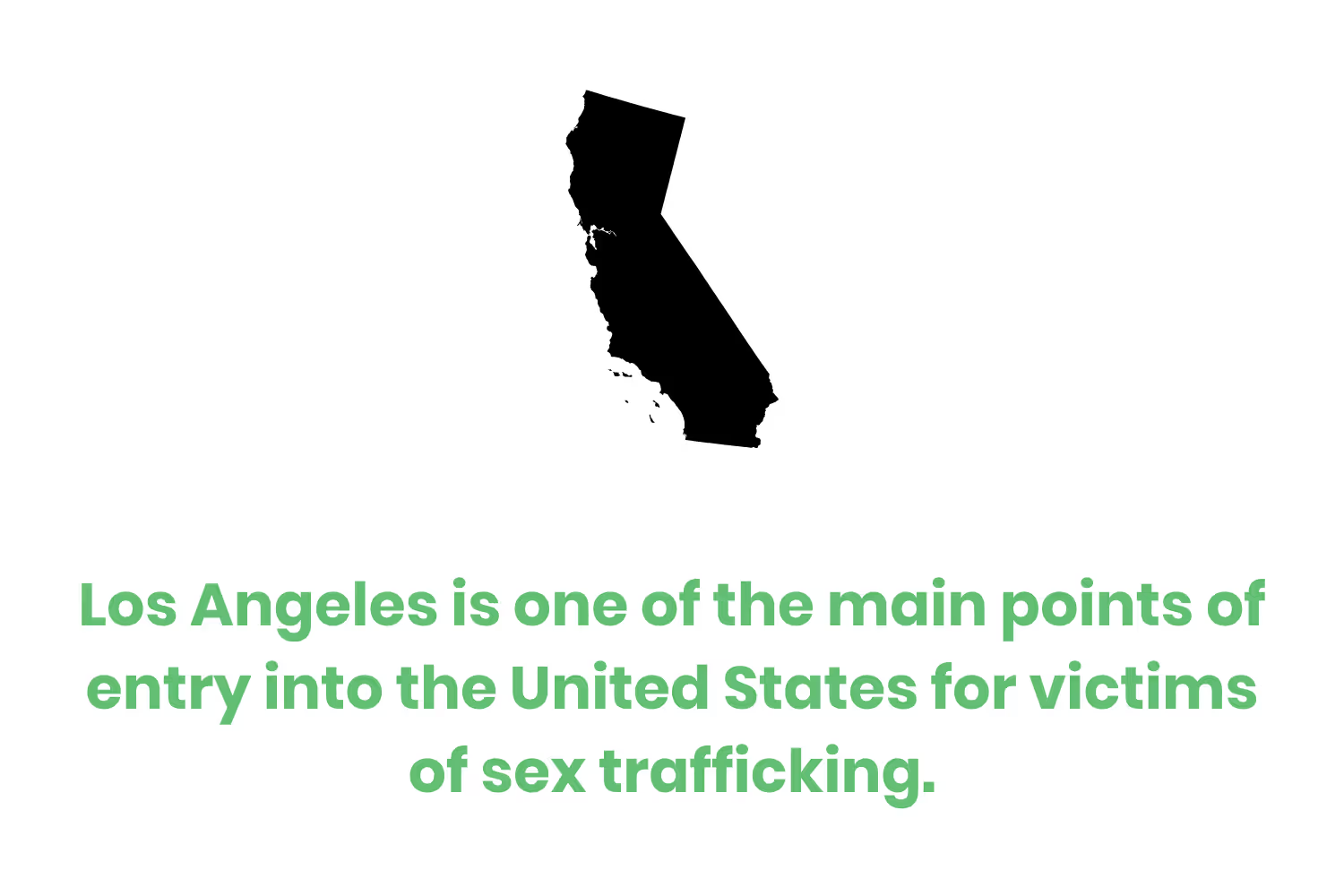
- In 2020, the Los Angeles Regional Human Trafficking Task Force’s “Operation Reclaim and Rebuild” ended with 518 arrests and the rescue of 87 victims. (AP News)
- One of the main points of entry into the United States for victims of sex trafficking is Los Angeles. Meanwhile, San Francisco is experiencing an increase in the number of sex trafficking cases. (Chest of Hope)
- Almost 1 in 10 homeless individuals in Los Angeles reported being sex or labor trafficked (Cast)
- 1 in 5 homeless youth in California has experienced some form of trafficking, with 14% experiencing sex trafficking, 8% experiencing labor trafficking, and 3% experiencing forms of both. (Loyola University)
- As of January 1, 2020, California hotel and motel employers must provide a 20-minute human trafficking training to employees once every two years, and within six months of the employee’s hire in that role. (DLA Piper)
Florida Human Trafficking Statistics
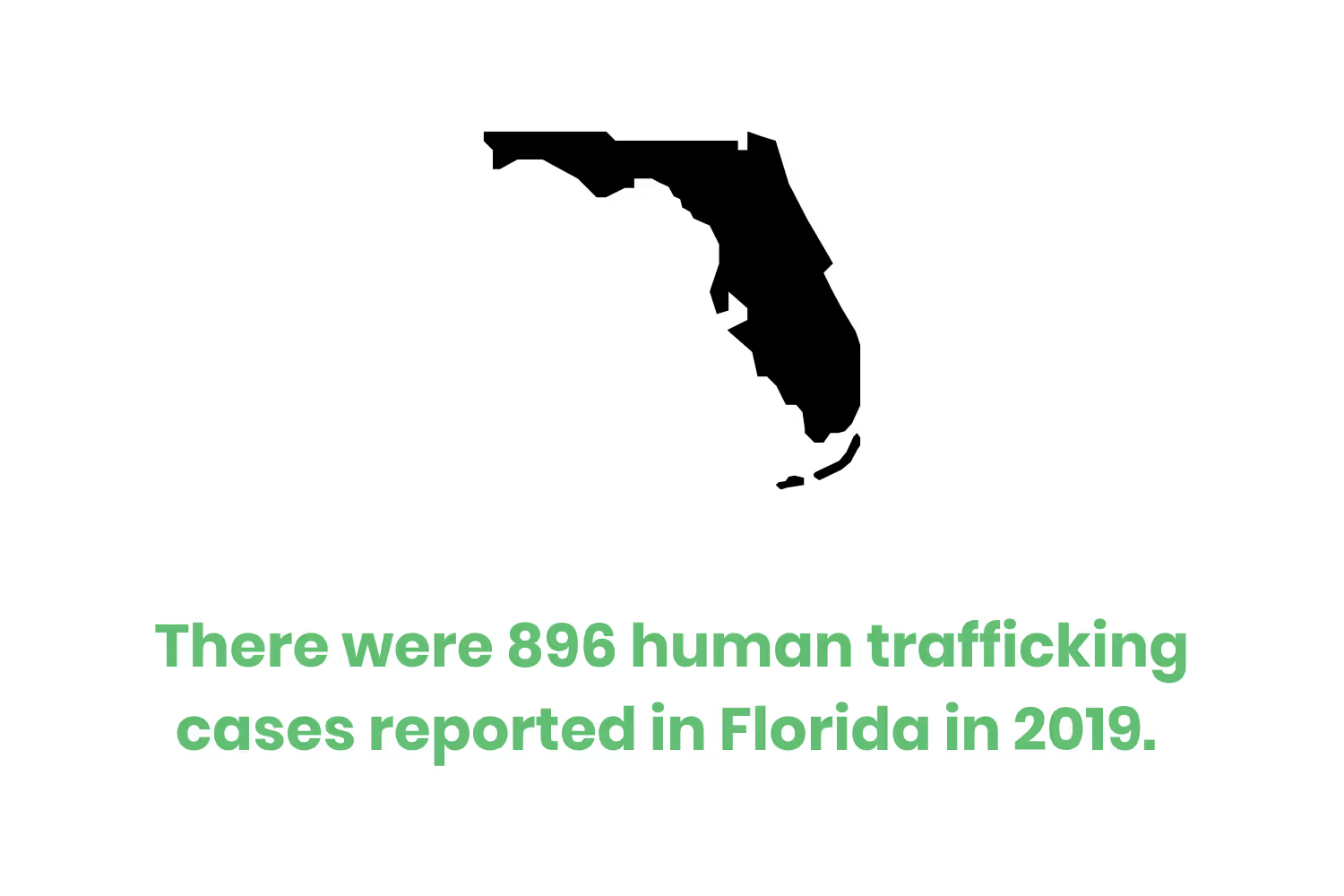
- There were 896 human trafficking cases reported in Florida in 2019. (National Human Trafficking Hotline)
- Trafficking adults or children is a felony in Florida (Online Sunshine)
- The life expectancy for a child taken into sex trafficking is only seven years from the date of capture. (News Channel 8)
- In 2018, The Tampa City Council passed a bathhouse ordinance to combat human trafficking. Only 21 bathhouses obtained the requested permit in 2020. (News Channel 8)
- In 2021, the University of South Florida, St. Petersburg Campus opened a lab devoted to studying human trafficking research in the state. (CBS Tampa Bay)
Iowa Human Trafficking Statistics

- 1350 individuals advertised themselves for sale for sexual conduct online every month in Iowa on the now-debunked Backpage.com in 2017. (Creighton University)
- Multiple area municipalities, hospitals, churches, schools, and community organizations report serving human trafficking victims in the Cedar Rapids area at some point. (Chains Interrupted)
- Iowa was one of 12 states involved in “Operation United Front” which rescued 47 victims and led to 102 arrests in 2021. (Who 13)
Minnesota Human Trafficking Statistics
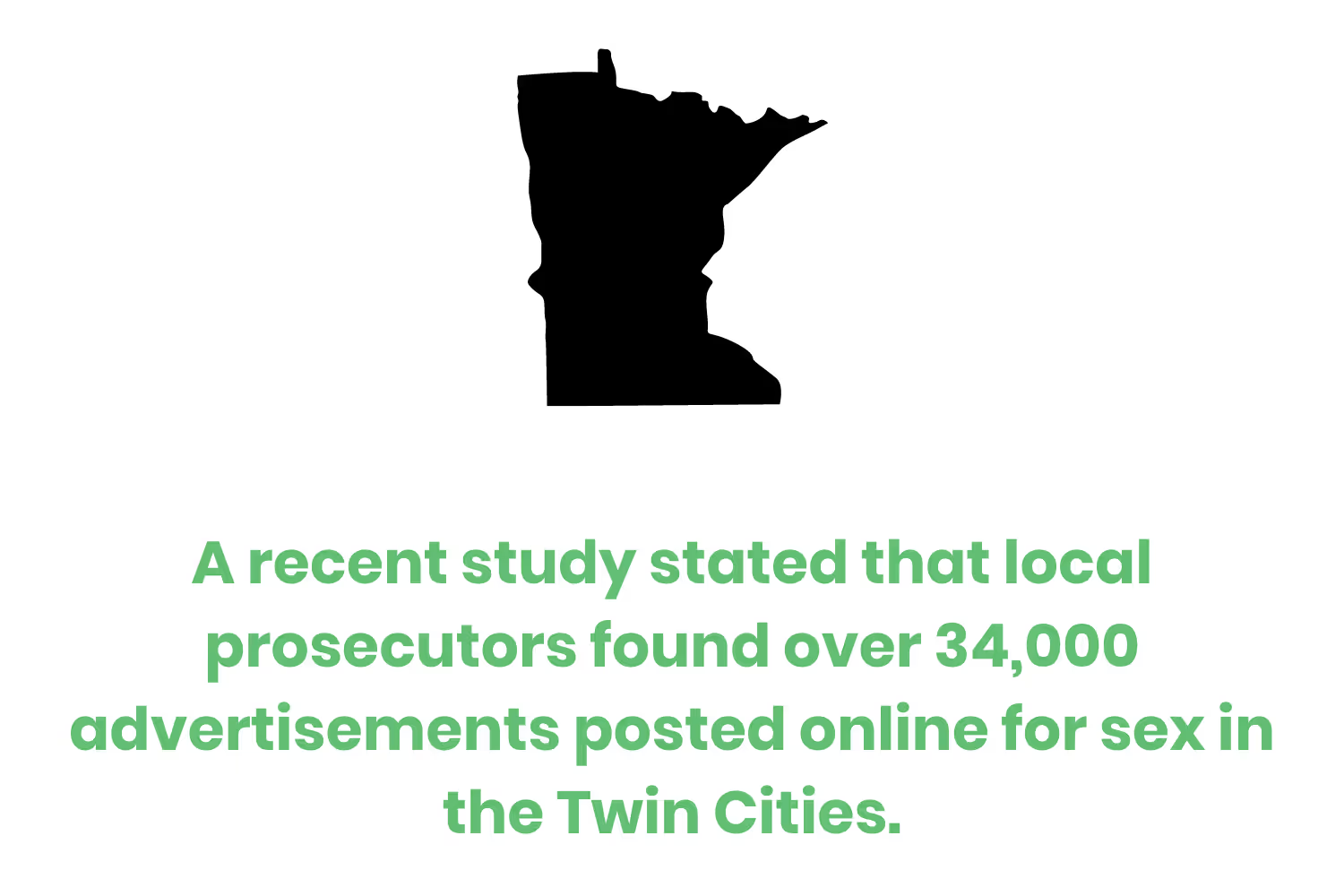
- A recent study stated that local prosecutors found over 34,000 advertisements posted online for sex in the Twin Cities. (The Office of The Minnesota Attorney General)
- Mall of America and nonprofit The Link joined forces to provide mandatory, in-person anti-trafficking training for more than 1,200 mall employees. (Minnesota Monthly)
- The Twin Cities ranks 14th among major U.S. cities for incidences of child prostitution. (MnDot)
The Money Behind Human Trafficking
It makes sense that human trafficking makes a great deal of profit. If it didn’t, such illegal activity wouldn’t occur. In fact, the abuse, drugs, and fear forced upon victims wouldn’t exist at all if there wasn’t a large payoff for those perpetrating the damage.
If companies don’t need to pay their workers, then any product made from those workers has low costs of goods sold, making the profit margins abnormally high. Specific industries make several billion dollars of profit each year from human trafficking activities including sexual exploitation, mining, fishing, and forced domestic work.
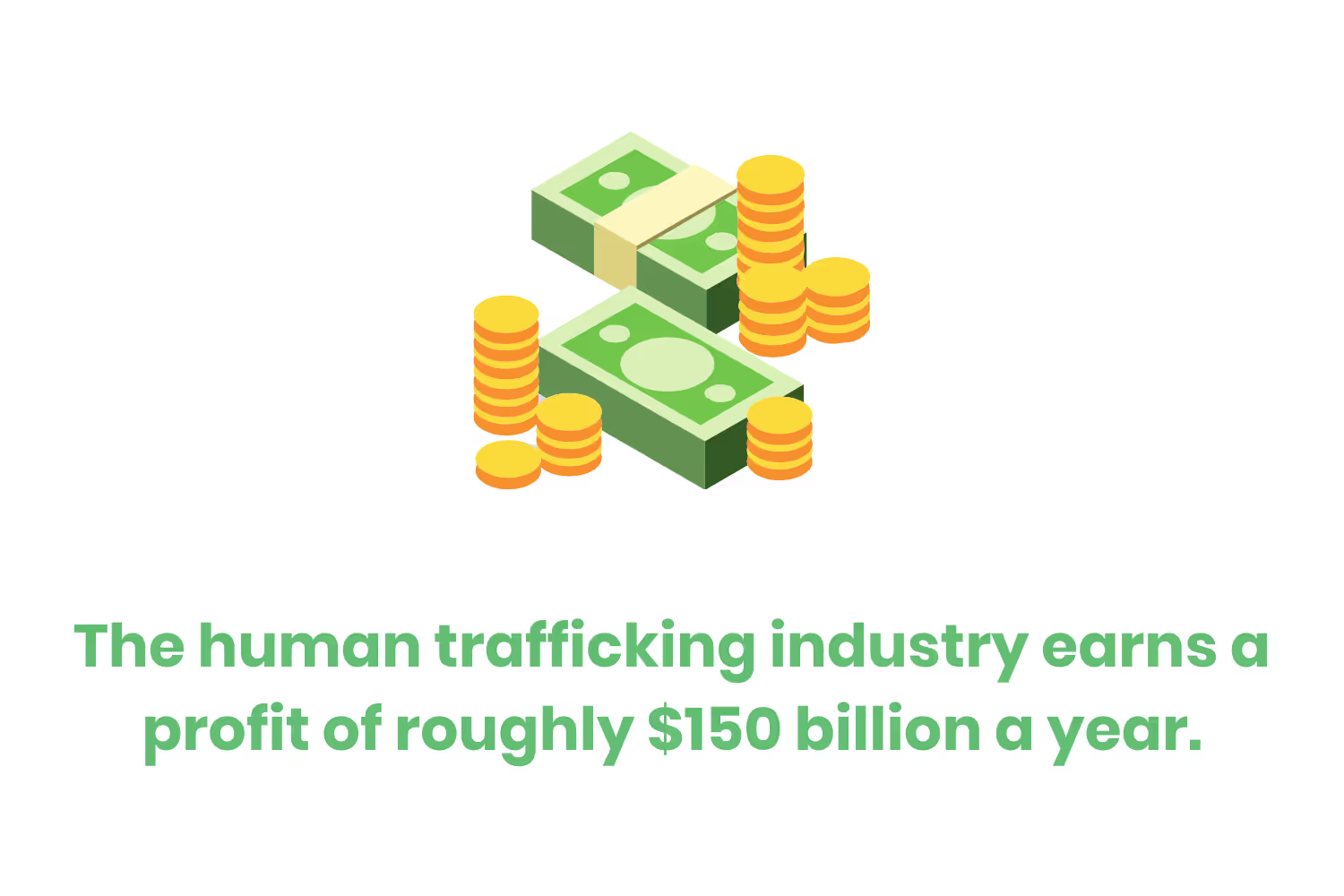
In the legal business, about 80% of profit comes from about 20% of customers. In a similar sense, that’s why even though a small percentage of victims are sexually exploited, this type of human trafficking makes over 60% of the industry's profit. It’s horrific, yet it’s the reality of the situation millions of people are facing.
Here are some facts that showcase how human trafficking creates profit for the perpetrators...
- The human trafficking industry earns a profit of roughly $150 billion a year. (Neal Davis Law)
- Nearly two-thirds, or $99 billion, of that profit, comes from commercial sexual exploitation. (Neal Davis Law)
- $34 billion of profit came from construction, manufacturing, mining, and utilities. (Human Rights First)
- $9 billion of profit came from agriculture, including forestry and fishing. (Human Rights First)
- Private households that employ domestic workers under forced labor conditions save $8 billion of profit annually. (Human Rights First)
- While only 19% of victims are sex trafficked, sexual exploitation earns 66% of the global profits of human trafficking. (Human Rights First)
- The average annual profit generated by each woman in forced sexual servitude is $100,000. This is about six times more than the average profits generated by each trafficking victim worldwide, or about $21,800. (Human Rights First)
- Studies show that sexual exploitation can yield a return on investment ranging from 100% to 1,000%. (Human Rights First)
- Enslaved laborers can produce more than 50% of profit, even in less profitable markets, like agriculture in India. (Human Rights First)
Labor Trafficking Statistics
Labor can mean a variety of things including working for households, government, or companies in a variety of conditions and typically without compensation.
Over 60% of the people who are victims of forced labor end up in the private economy. The remaining percent is in other forms of human trafficking. Nearly half of victims are in construction, manufacturing, mining, or hospitality industries.
These industries are typically those that locals aren’t willing to apply for, so the industries end up finding laborers elsewhere. This doesn’t mean that all construction companies use trafficked people. It also doesn’t mean that all domestic workers work in a household without pay for their services.

With that said, the industries listed below have high rates of trafficked people due to the ease of concealing how people are being ‘employed’, the amount on worker’s pay stubs, and how workers came to be ‘employed' at the company.
Here are 15 statistics to help you understand the forced labor aspect of human trafficking...
- 24.9 million people are victims of forced labor. (Neal Davis Law)
- 4.1 million people ended up in forced labor situations in state-imposed forced labor. (Safe Horizon)
- 16 million people end up in forced labor for the private economy. (Human Rights First)
- The private economy includes private individuals, groups, or companies in all sectors except the commercial sex industry. (Safe Horizon)
- The Asia-pacific region accounts for 62% of the global amount of forced laborers. (Human Rights First)
- Africa has 23% of the global amount of forced laborers. (Human Rights First)
- Europe and Central Asia have 9% of the global amount of forced laborers. (Human Rights First)
- North and South America account for 5% of the global amount of forced laborers. (Human Rights First)
- The Arab States account for 1% of all victims. (Human Rights First)
- Forced labor in the private economy generates an estimated $150 billion in illegal profits per year. (Safe Horizon)
- The largest share of labor trafficked adults is domestic workers (24%) followed by construction (18%), manufacturing (15%), and agriculture and fishing (11%) sectors. (Safe Horizon)
- 7.5 million (47%) forced labor victims to work in construction, manufacturing, mining, or hospitality. (Human Rights First)
- 3.8 million (24%) forced labor victims are domestic workers. (Human Rights First)
- 1.7 million (11%) forced labor victims to work in agriculture. (Human Rights First)
- Victims spend an average of 20 months in forced labor, although this varies with different forms of forced labor. (Human Rights First)
- Labor trafficking victims are more likely to be Hispanic (63%) or Asian (17%). (World Population Review)
Sex Trafficking Statistics
It’s well known that a big portion of the human trafficking industry involves sexual exploitation.
Three-fourths of victims of sexual exploitation don’t reside in the country where the events occurred. This doesn’t necessarily mean that they endured abduction and went abroad against their will. Some people end up in situations due to manipulation and coercion related to moving. They often end up in bad situations due to a web of deceit.
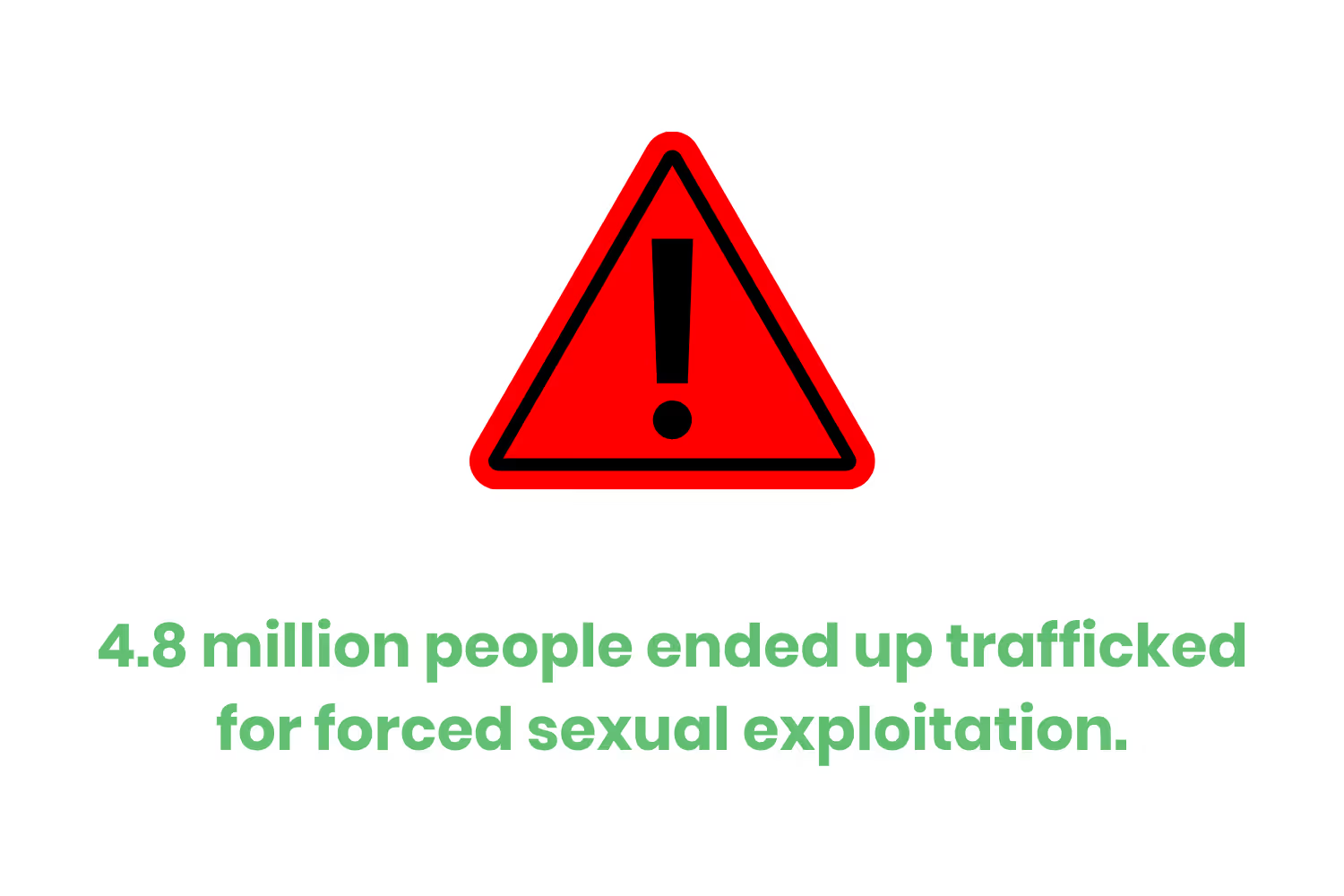
So who’s more at risk for this kind of human trafficking? 40% of sex trafficking victims are of African descent. This can be due to the environment of many minorities in white-dominant countries or due to the trafficking levels on the African continent. Caucasians are the second largest group targeted for sexual exploitation.
No matter how much melanin you have in your skin, your age, or your gender, everyone, and anyone is at risk of human trafficking. Below are five statistics to demonstrate what I mean.
- 4.8 million people ended up trafficked for forced sexual exploitation. (Safe Horizon)
- 1.0 million children ended up trafficked for commercial sexual exploitation. (Safe Horizon)
- 4.8 million human trafficking victims (19%) were sexually exploited. (Human Rights First)
- 3.5 million (74%) of victims of sexual exploitation were living outside their country of residence. (Human Rights First)
- Sex trafficking victims are more likely to be white (26%) or black (40%). (World Population Review)
Conclusion
As you can see, the situation isn’t pretty. Millions of people experience all sorts of abuse due to human trafficking. They lose days, months, and even years of their lives due to the selfishness of other people.
The best way to protect yourself and your family is to educate yourself and take preventative measures so that you aren't victimized.
Most people know not to walk alone at night. Many women carry a metal tool for self-defense, keys between knuckles, and pepper spray. People even take self-defense classes as a proactive way to deal with abduction situations.
Those are all good first steps, but you might need to take additional steps to keep yourself safe. How do you handle a situation where you or a friend consumes date rape drugs or something similar? A good first step would be to ask your local police station for advice about preventative measures.
If you ever feel like you are in danger, call 911. Please stay safe out there.
Emphasize your product's unique features or benefits to differentiate it from competitors
In nec dictum adipiscing pharetra enim etiam scelerisque dolor purus ipsum egestas cursus vulputate arcu egestas ut eu sed mollis consectetur mattis pharetra curabitur et maecenas in mattis fames consectetur ipsum quis risus mauris aliquam ornare nisl purus at ipsum nulla accumsan consectetur vestibulum suspendisse aliquam condimentum scelerisque lacinia pellentesque vestibulum condimentum turpis ligula pharetra dictum sapien facilisis sapien at sagittis et cursus congue.
- Pharetra curabitur et maecenas in mattis fames consectetur ipsum quis risus.
- Justo urna nisi auctor consequat consectetur dolor lectus blandit.
- Eget egestas volutpat lacinia vestibulum vitae mattis hendrerit.
- Ornare elit odio tellus orci bibendum dictum id sem congue enim amet diam.
Incorporate statistics or specific numbers to highlight the effectiveness or popularity of your offering
Convallis pellentesque ullamcorper sapien sed tristique fermentum proin amet quam tincidunt feugiat vitae neque quisque odio ut pellentesque ac mauris eget lectus. Pretium arcu turpis lacus sapien sit at eu sapien duis magna nunc nibh nam non ut nibh ultrices ultrices elementum egestas enim nisl sed cursus pellentesque sit dignissim enim euismod sit et convallis sed pelis viverra quam at nisl sit pharetra enim nisl nec vestibulum posuere in volutpat sed blandit neque risus.

Use time-sensitive language to encourage immediate action, such as "Limited Time Offer
Feugiat vitae neque quisque odio ut pellentesque ac mauris eget lectus. Pretium arcu turpis lacus sapien sit at eu sapien duis magna nunc nibh nam non ut nibh ultrices ultrices elementum egestas enim nisl sed cursus pellentesque sit dignissim enim euismod sit et convallis sed pelis viverra quam at nisl sit pharetra enim nisl nec vestibulum posuere in volutpat sed blandit neque risus.
- Pharetra curabitur et maecenas in mattis fames consectetur ipsum quis risus.
- Justo urna nisi auctor consequat consectetur dolor lectus blandit.
- Eget egestas volutpat lacinia vestibulum vitae mattis hendrerit.
- Ornare elit odio tellus orci bibendum dictum id sem congue enim amet diam.
Address customer pain points directly by showing how your product solves their problems
Feugiat vitae neque quisque odio ut pellentesque ac mauris eget lectus. Pretium arcu turpis lacus sapien sit at eu sapien duis magna nunc nibh nam non ut nibh ultrices ultrices elementum egestas enim nisl sed cursus pellentesque sit dignissim enim euismod sit et convallis sed pelis viverra quam at nisl sit pharetra enim nisl nec vestibulum posuere in volutpat sed blandit neque risus.
Vel etiam vel amet aenean eget in habitasse nunc duis tellus sem turpis risus aliquam ac volutpat tellus eu faucibus ullamcorper.
Tailor titles to your ideal customer segment using phrases like "Designed for Busy Professionals
Sed pretium id nibh id sit felis vitae volutpat volutpat adipiscing at sodales neque lectus mi phasellus commodo at elit suspendisse ornare faucibus lectus purus viverra in nec aliquet commodo et sed sed nisi tempor mi pellentesque arcu viverra pretium duis enim vulputate dignissim etiam ultrices vitae neque urna proin nibh diam turpis augue lacus.




